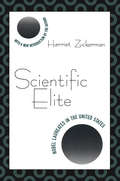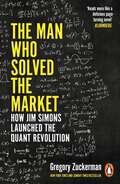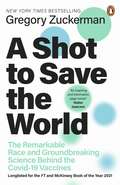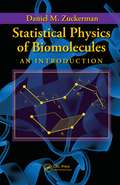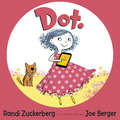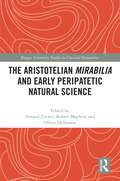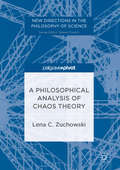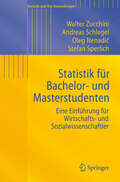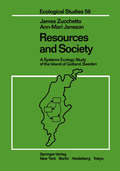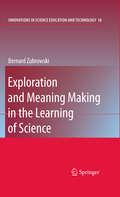- Table View
- List View
Inorganic Reactions and Methods, The Formation of Bonds to Group-I, -II, and -IIIB Elements (Inorganic Reactions and Methods #28)
by J. J. ZuckermanInorganic Reactions and Methods systemizes the discipline of modern inorganic chemistry according to a plan constructed by a council of editorial advisors and consults that include three Nobel laureates (E.O. Fischer, H. Taube, and G. Wilkinson). Rather than producing a collection of unrelated review articles, this series creates a framework that reflects the creative potential of this scientific discipline. In a clear, concise, and highly organized manner, it provides an in-depth treatment of bond formation reactions categorized by element type. The series covers all areas of inorganic chemistry including chemistry of the elements, coordination compounds, donor-acceptor adducts, organometallic, polymer and solid-state material, and compounds relevant to bioinorganic chemistry. A unique index system provides users with several fast options for accessing information on forming any bond type, compound, or reaction. Coverage of both classical chemistry and the frontiers of today's research make this series a valuable reference for years to come.
Inorganic Reactions and Methods, The Formation of Bonds to Group VIB (Inorganic Reactions and Methods #10)
by J. J. ZuckermanFor the first time the discipline of modern inorganic chemistry has been systematized according to a plan constructed by a council of editorial advisors and consultants, among them three Nobel laureates (E.O. Fischer, H. Taube and G. Wilkinson). Rather than producing a collection of unrelated review articles, the series creates a framework which reflects the creative potential of this scientific discipline. Thus, it stimulates future development by identifying areas which are fruitful for further research. The work is indexed in a unique way by a structured system which maximizes its usefulness to the reader. It augments the organization of the work by providing additional routes of access for specific compounds, reactions and other topics.
Inorganic Reactions and Methods, The Formation of Bonds to Halogens (Inorganic Reactions and Methods #45)
by J. J. ZuckermanFor the first time the discipline of modern inorganic chemistry has been systematized according to a plan constructed by a council of editorial advisors and consultants, among them three Nobel laureates (E.O. Fischer, H. Taube and G. Wilkinson). Rather than producing a collection of unrelated review articles, the series creates a framework which reflects the creative potential of this scientific discipline. Thus, it stimulates future development by identifiying areas which are fruitful for further research. The work is indexed in a unique way by a structured system which maximizes its usefulness to the reader. It augments the organization of the work by providing additional routes of access for specific compounds, reactions and other topics.
Inorganic Reactions and Methods, The Formation of Bonds to Halogens (Inorganic Reactions and Methods #46)
by J. J. ZuckermanFor the first time the discipline of modern inorganic chemistry has been systematized according to a plan constructed by a council of editorial advisors and consultants, among them three Nobel laureates (E.O. Fischer, H. Taube and G. Wilkinson). Rather than producing a collection of unrelated review articles, the series creates a framework which reflects the creative potential of this scientific discipline. Thus, it stimulates future development by identifying areas which are fruitful for further research. The work is indexed in a unique way by a structured system which maximizes its usefulness to the reader. It augments the organization of the work by providing additional routes of access for specific compounds, reactions and other topics.
Inorganic Reactions and Methods, The Formation of Bonds to N,P,As,Sb,Bi (Inorganic Reactions and Methods #14)
by J. J. ZuckermanThis 18-volume series is a true first. In a clear, concise, and highly organized manner, it provides an in-depth treatment of bond formation reactions categorized by element type. The series presents current knowledge in all areas of inorganic chemistry including chemistry of the elements, coordination compounds, donor-acceptor adducts, organometallic, polymer and solid-state material, and compounds relevant to bioinorganic chemistry. A unique index system provides users with several fast options for accessing information on forming any bond type, compound, or reaction. Coverage of both classical chemistry and the frontiers of today's research makes this series a valuable reference for years to come.
Inorganic Reactions and Methods, The Formation of Bonds to N, P, As, Sb, Bi (Inorganic Reactions and Methods #16)
by J. J. ZuckermanFor the first time the discipline of modern inorganic chemistry has been systematized according to a plan constructed by a council of editorial advisors and consultants, among them three Nobel laureates (E.O. Fischer, H. Taube and G. Wilkinson). Rather than producing a collection of unrelated review articles, the series creates a framework which reflects the creative potential of this scientific discipline. Thus, it stimulates future development by identifying areas which are fruitful for further research. The work is indexed in a unique way by a structured system which maximizes its usefulness to the reader. It augments the organization of the work by providing additional routes of access for specific compounds, reactions and other topics.
Inorganic Reactions and Methods, The Formation of Bonds to O, S, Se, Te, Po (Zuckerman: Inorganic Reactions and Methods #12)
by J. J. ZuckermanBoasting numerous industrial applications, inorganic chemistry forms the basis for research into new materials and bioinorganic compounds such as calcium that act as biological catalysts. Now complete, this highly acclaimed series presents current knowledge in all areas of inorganic chemistry, including chemistry of the elements; organometallic, polymeric and solid-state materials; and compounds relevant to bioinorganic chemistry.
Inorganic Reactions and Methods, The Formation of Bonds to Transition and Inner-Transition Metals (Zuckerman: Inorganic Reactions and Methods #30)
by J. J. ZuckermanBoasting numerous industrial applications, inorganic chemistry forms the basis for research into new materials and bioinorganic compounds such as calcium that act as biological catalysts. Now complete, this highly acclaimed series presents current knowledge in all areas of inorganic chemistry, including chemistry of the elements; organometallic, polymeric and solid-state materials; and compounds relevant to bioinorganic chemistry.
Inorganic Reactions and Methods, Formation of Ceramics (Zuckerman: Inorganic Reactions and Methods #38)
by J. J. ZuckermanBoasting numerous industrial applications, inorganic chemistry forms the basis for research into new materials and bioinorganic compounds such as calcium that act as biological catalysts. Now complete, this highly acclaimed series presents current knowledge in all areas of inorganic chemistry, including chemistry of the elements; organometallic, polymeric and solid-state materials; and compounds relevant to bioinorganic chemistry.
Inorganic Reactions and Methods, Oligomerization and Polymerization Formation of Intercalation Compounds (Inorganic Reactions and Methods #36)
by J. J. ZuckermanFor the first time the discipline of modern inorganic chemistry has been systematized according to a plan constructed by a council of editorial advisors and consultants, among them three Nobel laureates (E.O. Fischer, H. Taube and G. Wilkinson). Rather than producing a collection of unrelated review articles, the series creates a framework which reflects the creative potential of this scientific discipline. Thus, it stimulates future development by identifying areas which are fruitful for further research. The work is indexed in a unique way by a structured system which maximizes its usefulness to the reader. It augments the organization of the work by providing additional routes of access for specific compounds, reactions and other topics.
Inorganic Reactions and Methods, Reactions Catalyzed by Inorganic Compounds (Inorganic Reactions and Methods #34)
by J. J. ZuckermanFor the first time the discipline of modern inorganic chemistry has been systematized according to a plan constructed by a council of editorial advisors and consultants, among them three Nobel laureates (E.O. Fischer, H. Taube and G. Wilkinson). Rather than producing a collection of unrelated review articles, the series creates a framework which reflects the creative potential of this scientific discipline. Thus, it stimulates future development by identifying areas which are fruitful for further research. The work is indexed in a unique way by a structured system which maximizes its usefulness to the reader. It augments the organization of the work by providing additional routes of access for specific compounds, reactions and other topics.
Scientific Elite: Nobel Laureates in the United States
by Harriet ZuckermanScientific Elite is about Nobel prize winners and the well-defined stratification system in twentieth-century science. It tracks the careers of all American laureates who won prizes from 1907 until 1972, examining the complex interplay of merit and privilege at each stage of their scientific lives and the creation of the ultra-elite in science.The study draws on biographical and bibliographical data on laureates who did their prize-winning research in the United States, and on detailed interviews with forty-one of the fifty-six laureates living in the United States at the time the study was done. Zuckerman finds laureates being successively advantaged as time passes. These advantages are producing growing disparities between the elite and other scientists both in performance and in rewards, which create and maintain a sharply graded stratification system.
The Man Who Solved the Market: How Jim Simons Launched the Quant Revolution SHORTLISTED FOR THE FT & MCKINSEY BUSINESS BOOK OF THE YEAR AWARD 2019
by Gregory ZuckermanSHORTLISTED FOR THE FT AND MCKINSEY BUSINESS BOOK OF THE YEAR AWARD 2019'Reads more like a delicious page-turning novel...Put it on your holiday gift list for your favourite hedge-fund honcho' BloombergJim Simons is the greatest moneymaker in modern financial history. His record bests those of legendary investors, including Warren Buffett, George Soros and Ray Dalio. Yet Simons and his strategies are shrouded in mystery. The financial industry has long craved a look inside Simons's secretive hedge fund, Renaissance Technologies and veteran Wall Street Journal reporter Gregory Zuckerman delivers the goods. After a legendary career as a mathematician and a stint breaking Soviet codes, Simons set out to conquer financial markets with a radical approach. Simons hired physicists, mathematicians and computer scientists - most of whom knew little about finance - to amass piles of data and build algorithms hunting for the deeply hidden patterns in global markets. Experts scoffed, but Simons and his colleagues became some of the richest in the world, their strategy of creating mathematical models and crunching data embraced by almost every industry. As Renaissance became a major player in the financial world, its executives began exerting influence on other areas. Simons became a major force in scientific research, education and Democratic politics, funding Hilary Clinton's presidential campaign. While senior executive Robert Mercer is more responsible than anyone else for the Trump presidency, placing Steve Bannon in the campaign, funding Trump's victorious 2016 effort and backing alt-right publication Breitbart. Mercer also impacted the success of the Brexit campaign. For all his prescience, Simons failed to anticipate how Mercer's activity would impact his firm and the world. In this fast-paced narrative, Zuckerman examines how Simons launched a quantitative revolution on Wall Street, and reveals the impact that Simons, the quiet billionaire king of the quants, has had on worlds well beyond finance.
A Shot to Save the World: The Remarkable Race and Ground-Breaking Science Behind the Covid-19 Vaccines
by Gregory ZuckermanThis is the definitive account of the global effort to develop a vaccine for Covid-19, charting the failure and success of every major vaccine in use.When the coronavirus pandemic hit, many of the world's biggest drug and vaccine makers were slow to react or couldn't muster an effective response. It was up to a small group of unlikely and untested scientists and executives to save civilization; a French businessman dismissed by many as a fabulist, a Turkish immigrant with little virus experience, a quirky American Midwesterner obsessed with insect cells, a Boston scientist employing questionable techniques, a British scientist despised by his peers. They scrambled to turn their life's work into life-saving vaccines in a matter of months, each gunning to make the big breakthrough - and to beat each other for the glory that a vaccine guaranteed.A number-one New York Times bestselling author and award-winning Wall Street Journal investigative journalist, Zuckerman takes us inside the top-secret laboratories, corporate clashes and high-stakes government negotiations that led to effective vaccines development and roll out. Meticulously reported and endlessly gripping, this is a dazzling, blow-by-blow chronicle of the most consequential scientific breakthrough of our time. It's a story of courage, genius and heroism, optimism. It's also a tale of heated rivalries, unbridled ambitions, crippling insecurities and unexpected drama.A Shot to Save the World is the story of how science saved the world.
Statistical Physics of Biomolecules: An Introduction
by Daniel M. ZuckermanFrom the hydrophobic effect to protein-ligand binding, statistical physics is relevant in almost all areas of molecular biophysics and biochemistry, making it essential for modern students of molecular behavior. But traditional presentations of this material are often difficult to penetrate. Statistical Physics of Biomolecules: An Introduction brin
Dot.: Untangling Our Wired Lives
by Randi ZuckerbergDot is a clever little girl, well-versed in how to use electronic devices. Dot knows a lot. She knows how to tap . . . to swipe . . . to share . . . online, but she's forgotten how to do things in the world surrounding her . . .Dot's tech-savvy expertise, mingled with her resourceful imagination, proves Dot really does know lots and lots.
Fundamentals of Gas Dynamics
by Robert D. Zucker Oscar BiblarzProvides all necessary equations, tables, and charts as well as self tests. Included chapters cover reaction propulsion systems and real gas effects. Written and organized in a manner that makes it accessible for self learning.
The Aristotelian Mirabilia and Early Peripatetic Natural Science (Rutgers University Studies in Classical Humanities)
by Arnaud ZuckerThis is the first volume devoted to the sections of the Aristotelian Mirabilia on natural science, filling a significant gap in the history of the Aristotelian study of nature and especially of animals. The chapters in this volume explore the Mirabilia, or De mirabilibus auscultationibus (On Marvelous Things Heard), and its engagement with the natural sciences. The first two chapters deliver an introduction to this work: one a discussion of the history of the text; the other a discussion of Aristotelian epistemology and methodology, and the role of the Mirabilia in that context. This is followed by eight chapters that, together, are effectively a commentary on those sections of the Mirabilia with close connections to Aristotle’s Historia animalium and to a number of Theophrastus’ scientific treatises. Finally, the volume ends with two chapters on thematic topics connected to natural science running throughout the work, namely color and disease. The Aristotelian Mirabilia and Early Peripatetic Natural Science should prove invaluable to scholars and students interested in the ancient Greek study of nature, ancient philosophy, and Aristotelian science in particular.
A Philosophical Analysis of Chaos Theory
by Lena C. ZuchowskiThis book provides an analysis of the construction, diagnosis (as chaotic) and evaluation of models in chaos theory. It contains a detailed look at the interaction of the different models used in chaos theory and analyses how these models influence the way chaos is defined. Furthermore, the book discusses the conditions for the occurrence of chaos and the detection of chaos in nature.
A Philosophical Analysis of Chaos Theory
by Lena C. ZuchowskiThis book provides an analysis of the construction, diagnosis (as chaotic) and evaluation of models in chaos theory. It contains a detailed look at the interaction of the different models used in chaos theory and analyses how these models influence the way chaos is defined. Furthermore, the book discusses the conditions for the occurrence of chaos and the detection of chaos in nature.
Statistik für Bachelor- und Masterstudenten: Eine Einführung für Wirtschafts- und Sozialwissenschaftler (Statistik und ihre Anwendungen)
by Walter Zucchini Andreas Schlegel Oleg Nenadic Stefan SperlichDas Buch führt in die wesentlichen statistischen Konzepte und Ideen ein und erläutert anhand von Beispielen detailliert deren Umsetzung. Der Stil ist, anders als bei den meisten Konkurrenzwerken, betont locker gehalten - ohne dabei auf eine exakte Darstellung zu verzichten. Das Buch ist speziell auf die Bedürfnisse von Anfängern im Fach Statistik zugeschnitten und für Bachelor- und Masterstudenten aller Disziplinen geeignet – auch zum Selbststudium.
Resources and Society: A Systems Ecology Study of the Island of Gotland, Sweden (Ecological Studies #56)
by James Zucchetto Ann-Mari JanssonAlthough this book is about a specific area of the world (i.e., Gotland, Sweden), the interdisciplinary nature of the study, with regard to resources, environment, and society, makes it of interest to a number of fields. We have tried to make this book readable for a wide variety of interested parties including systems ecologists, environmental scientists, resource economists, geographers, regional planners, and regional scientists, as well as those interested in Nordic conditions. Since this project was part of UNESCO's Man and the Biosphere (MAB) pro gram, this book should be of general interest to the international community. This book is certainly not a textbook, but we see it as being useful for courses in regional analysis with plenty of examples for illustrating analysis and models related to energy, environment, and economics, or to the general field of systems ecology. An instructor could, of course, supplement the material on systems and models with other sources. We hope this small book will serve as a helpful example of the analysis of the complex interdisciplinary problems associated with resources and society. In Chapter 1, we present a brief introduction to the Gotland study as well as to some of the concepts and theories that have guided our investigations.
DNA Nanotechnology: Methods and Protocols (Methods in Molecular Biology #1811)
by Giampaolo ZuccheriThis second edition provides new and updated methods that detail new DNA nanotechnology techniques. Chapters focus on DNA origami nanostructures for arranging matter in the nanoscale or on their manipulation with the aid of other technologies, on procedures for making nucleic acids nanostructures of different kinds, and methods to simulate complex nanostructures or to use them in biosensing. Written in the highly successful Methods in Molecular Biology series format, chapters include introductions to their respective topics, lists of the necessary materials and reagents, step-by-step, readily reproducible laboratory protocols, and tips on troubleshooting and avoiding known pitfalls.Authoritative and cutting-edge, DNA Nanotechnology: Methods and Protocols, Second Edition aims to ensure successful results in the further study of this vital field.
Exploration and Meaning Making in the Learning of Science (Innovations in Science Education and Technology #18)
by Bernard ZubrowskiMountaineers, Rock Climbers, and Science Educators Around the 1920s, rock climbing separated from mountaineering to become a separate sport. At that time European climbers developed new equipment and techniques, enabling them to ascend mountain faces and to climb rocks, which were considered unassailable up to that time. American climbers went further by expanding and improving on the equipment. They even developed a system of quantification where points were given for the degree of difficulty of an ascent. This system focused primarily on the pitch of the mountain, and it even calculated up to de- mals to give a high degree of quantification. Rock climbing became a technical system. Csikszentmihaly (1976) observed that the sole interest of rock climbers at that time was to climb the rock. Rock climbers were known to reach the top and not even glance around at the scenery. The focus was on reaching the top of the rock. In contrast, mountaineers saw the whole mountain as a single “unit of perc- tion. ” “The ascent (to them) is a gestalt including the aesthetic, historical, personal and physical sensations” (Csikszentmihaly, 1976, p. 486). This is an example of two contrasting approaches to the same kind of landscape and of two different groups of people. Interestingly, in the US, Europe, and Japan a large segment of the early rock climbers were young mathematicians and theoretical physicists, while the mountaineers were a more varied lot.
The Organic Chem Lab Survival Manual: A Student's Guide to Techniques
by James W. ZubrickWritten for the laboratory that accompanies the sophomore/junior level courses in Organic Chemistry, Zubrick provides students with a valuable guide to the basic techniques of the Organic Chemistry lab. The book will help students understand and practice good lab safety. It will also help students become familiar with basic instrumentation, techniques and apparatus and help them master the latest techniques such as interpretation of infrared spectroscopy. The guide is mostly macroscale in its orientation.











